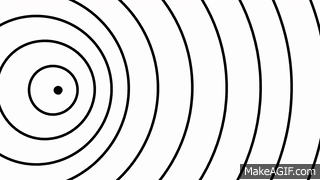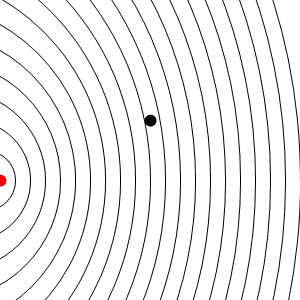SPREAD TO HELP OTHERS
Today we are going to talk about THE DOPPLER EFFECT , it is a very important concept of acoustic physics. Doppler effect is also known as Doppler shift , which is named after the Austrian Physicist Christian Doppler, who described this phenomenon in 1842.
* DOPPLER EFFECT
When there is a relative motion between source of the sounds waves/light waves and the observer along the line joining them , then the frequency observed by the observer is different from the actual frequency of the sound source.
This phenomenon is called Doppler effect (or Doppler shift).


If the observer and the source are moving towards each other then the observed frequency is greater than the actual frequency of the source. And if they are moving away from each other then the observed frequency is smaller than the actual frequency of the source.
Before going further take a look on this relative notation.
v = velocity of the sound waves w.r.t ground.
Vo = velocity of the observer.
Vs = velocity of the source.
* IF SOUND SOURCE IS MOVING AND OBSERVER IS STATIONARY
Tap the play button, and see the demonstration of Doppler effect.
If the sound source is emitting the sound waves of frequency f and moving with the velocity Vs towards the observer , then the ratio of the observed frequency to the actual frequency is-
f’/f = (v/v-Vs) ,
Observed frequency is f’ = (v/v-Vs).f
Apparent wavelength is λ’ = (v-Vs/v).λ
In this expression , the positive direction is taken along the velocity of the sound that is , from source to the observer.
Vs is positive if the sound source is travelling towards the observer and Vs is negative if sound source is travelling away from the observer.

* IF SOUND SOURCE IS STATIONARY AND OBSERVER IS MOVING WITH VELOCITY Vo.
If the sound source (rest) is emitting the sound waves of frequency f and observer is moving with the velocity Vo , away from the source, then the ratio of the observed frequency to the actual frequency is-
f’/f = (v-Vo/v)
Observed frequency is f’ = (v-Vo/v).f
Apparent wavelength is λ’ = (v/v-Vo).λ
In this expression , the positive direction is taken along the velocity of the sound that is , from source to the observer.
Vo is positive if the observer is travelling away from the source and Vo is negative if observer is travelling towards the sound source.
* IF SOURCE AND THE OBSERVER BOTH ARE MOVING WITH VELOCITIES Vs AND Vo.
If both source and the observer are moving with the velocities Vs and Vo , then the ratio of the observed frequency to the actual frequency is-
WHEN THEY ARE MOVING AWAY FROM EACH OTHER
When they are moving away from each other then, the ratio of the observed frequency to the actual frequency is-
f ‘/f = [v-Vo/v-(-Vs)]
Observed frequency f’ is = [v-Vo/v-(-Vs)].f
Apparent wavelength is λ’ = [v-(-Vs)/v-Vo].λ
In this expression , the positive direction is taken along the velocity of the sound that is , from source to the observer.
In this situation , when both source and observer are moving away from each other, then we saw that sound source is moving in opposite direction that of the sound waves , it means Vs is negative.
But observer is moving in the direction of the sound waves, it means Vo is positive. See below..

WHEN THEY ARE MOVING TOWARDS EACH OTHER
When they are moving towards each other then, the ratio of the observed frequency to the actual frequency is-
f ‘/f = [v-(-Vo)/v-Vs]
Observed frequency f’ is = [v-(-Vo)/v-Vs).f
Apparent wavelength is λ’ = [v-Vs/v-(-Vo)].λ
In this expression , the positive direction is taken along the velocity of the sound waves that is , from source to the observer.
In this situation , when both source and observer are moving towards from each other, then we saw that sound source is moving in the direction of the sound waves , it means Vs is positive.
But observer is moving in the opposite direction that of the sound waves, it means Vo is negative.
WHY DOES DOPPLER EFFECT OCCURS
If we want to understand that why does Doppler effect occurs ,then first of all , we have to understand the some basic features of the sound waves.
We know that sound waves is the type of longitudinal waves , in which particles of the medium oscillates (to and fro motion) in the direction or opposite direction of the propagation of the waves in the form of compression or rarefaction.
All waves usually propagate in the form of wave front, Sound waves have spherical wave fronts but when we see it from side it seems us circular.
When sound source is stationary and it emits waves of wavelength λ and frequency f, then this waves propagate uniformly in all directions (3-dimensionally) at the same rate , having same wavelength , frequency and pitch at any instant.
But when this sound source starts moving away or towards the observer, the produced waves didn’t propagate uniformly in all the direction at the same rate.
If sound source is moving towards the observer then the wave fronts gets compressed , in the direction of the motion of the sound source.
Due to this wavelength gets shorten and frequency ( no of waves per second) gets increased, and then waves takes short time to reach the observer’s ears. and observer hears the Sound of high frequency or high pitch.

But when sound source is moving away from the observer then the wave fronts gets stretched in the opposite direction of the motion of the sound source. Due to this wavelength gets increased and frequency gets decreased, and then waves takes slightly more time to reach the observer’s ears, and observer hears the sound of low frequency or low pitch.
REMEMBER : The change in wavelength and frequency, which is experienced by the observer is apparent. The actual frequency and wavelength of the source didn’t change.
SPREAD TO HELP OTHERS